
Oh, hello there. You’ve caught me reminiscing about EA before they became one of the most successful, and controversial video game companies in the world. So, I thought I would compile a list of my Top 20 EA Games Of The 20th Century. There was a time when they were more commonly known as Electronic Arts, than the apathetic acronym we now know them as. It was the spring of 1982 when former Apple employee Trip Hawkins founded the company on a budget of $200,000. EA now generates a huge $5.5 billion annually through games, franchises, online content, studio acquisitions, and various partnerships. This makes them the second most successful video game company outside of Japan, second only to Activision Blizzard.
It Wasn’t Always Sports And Star Wars You Know!
Trip stayed with the company as CEO until 1990, where he was succeeded by Larry Probst. Larry stayed with EA until 1999 and it is within these time frames I have the fondest memories of their games. So grab your rose-tinted glasses and take a ‘Trip’ down memory lane as we look at the Top 20 EA Games Of The 20th Century…in my opinion. You will see a good amount of Sega on here as Electronic Arts didn’t really do a lot with Nintendo.
Did we miss anything out? Let us know in the comments below. Check you can see my latest feature on The History of Need For Speed here, and catch up with us on Instagram here.
Marble Madness (1986)
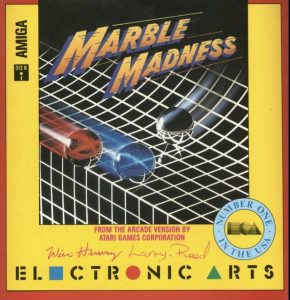
Marble Madness is an arcade game that was released in 1984 and designed by some guy called Mark Cerny. Mark Cerny, where do I know that name? Ah yes, the same Mark Cerny who was the lead architect for PlayStation 4, PlayStation 5, and the PS Vita. What was unique about this game is that it used a trackball as a controller. It wasn’t until 1986 when it started being ported to various systems up until the Blackberry in 2009, and Electronic Arts were publishing.
The game itself is simple but hard to master. Having drawn inspiration from mini-golf and racing games, the goal is to navigate your marble through various obstacles to reach the goal within the time limit. Marble Madness is set over 6 courses and any time remaining from the previous course will carry over on to the next one. As well as moving obstacles, there are tight corridors to navigate, and falling off the edge will lose you valuable seconds. Sounds easy right? It isn’t! Throw into the mix a little competitive two-player mode and you have to race each other to the finish. Trying to bash each other off the course is a particular highlight here. Marble Madness is a timeless classic, whichever system you play it on.
Skate Or Die (1987)
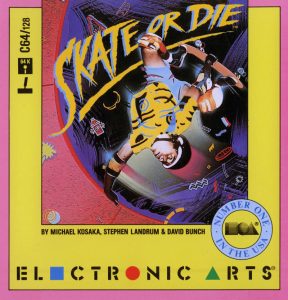
Welcome to Skate Or Die!. This is the first skate type game on our list. Both developed and published by Electronic Arts for home computers, and later ported on to the NES by Ultra Games and published by Konami. The NES version was the more popular with the rise of home consoles, but the Commodore 64 version really holds its own. Epyx was doing so well with the likes of California Games, Electronic Arts wanted a slice of that pie. So they created Skate or Die!, the most radical skateboarding game to date. The awesome English composer Rob Hubbard was brought on board for the music.
You and up to eight players take part in five events. There are two ramp events, two downhill events, and there is a pool joust. Don’t forget to visit the shop to buy your gear first. While it isn’t the most amazing game on this, it was a valiant effort to get with the competition and I have very fond memories of it. This is also the first game to be developed in-house by Electronic Arts and to be fair, it wasn’t a bad effort at all, but the best was yet to come.
Populous (1989)
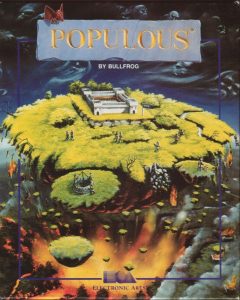
Hailed by many as the first God Game, Populous is one of the best selling PC games for a reason. Populous was the second game developed by Bullfrog Productions, a company founded by Peter Molyneux…yes THAT Peter Molyneux. Subsequently, EA went on to acquire the studio fighting off competition from the likes of Virgin and Sony. Once again, maestro Rob Hubbard was at the helm of music composition with David Hanlan. During development, a prototype was made using LEGO. Such was the popularity of Populous, it sold over four million copies on PC and saw ports to home consoles with favourable reviews. A Commodore 64 version was in the works, but unfortunately, it never got finished.
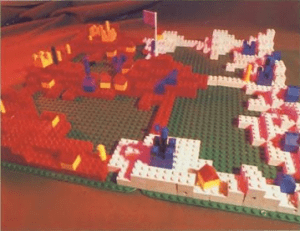
You are God! Basically, you are the precursor to what we now call a social media influencer. Set on an isometric landscape, your role is to lead your followers and eliminate the followers of your enemy God thus increasing your population. Using your mana powers you have the ability through divine intervention to create volcanoes, earthquakes, floods, and other world-ending natural phenomena. As you build more houses, you increase your followers and increase your mana giving you the best opportunities to overcome your enemy. This is the ultimate game of conquest and world domination, ridding the world of heretics one by one.
Shadow Of The Beast (1991)
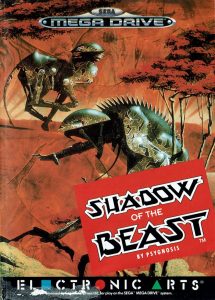
Like Populous, Shadow Of The Beast first saw light on the Amiga in 1989 and was ported to many systems later. Initially developed by Reflections (now Ubisoft Reflections) and published by Psygnosis, two companies that enjoyed a healthy relationship for many years. But, for the outing on Sega’s flagship system, the Mega Drive, Psygnosis took on the development duties while Electronic Arts dealt with the publishing. The game was designed to be as difficult as possible and has even featured in another well known Psygnosis title called Lemmings. Shadow Of The Beast was very well known for its graphics and received two sequels and a rather good remake on the PlayStation 4 in 2016.
You play as Aarbron, once a human but captured as a child. Through magic, you are transformed into a beast-servant of the Beast Lord, Maletoth. Whilst out and about doing a little murdering, you come across a human about to be sacrificed. Aarbron recognises this man as his father. Until now, Aarbron has no recollection of this past other than being a tormented monster, but seeing his father right before he dies stirs an ancient memory. Aarbron, now filled with hate and rage takes on a journey of revenge to defeat Maletoth and return to human form to become the Shadow Of The Beast.
Shadow Of The Beast is a 2D side-scrolling platform game on which you have to take down Maletoth’s minions, collect keys to open up new areas and avoid traps while doing so. The difficulty comes from the fact you have to be very accurate with your attacks. You only have one life as well with hit points. These hit points can be replenished, but the items to do so are very well hidden. If you haven’t played this, I implore you to do so, it is challenging but a fantastic story. The game itself took nine months to develop featuring 132 different monsters across 350 screens.
F-22 Interceptor (1991)
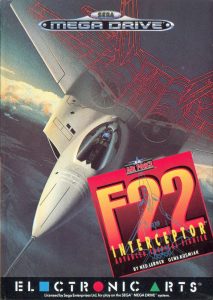
Maybe a bit of an unexpected entry on this list, F-22 Interceptor is a personal favourite of mine. Following the disappointing flight sim that was LHX Attack Chopper, Electronic Arts enlisted the expertise of Ned Lerner. Lerner was a leader in the field of 3D simulation game design and created the first 3D system for Electronic Arts. The Player Pilots the F-22 Raptor, which was based on a real aircraft, the F-22 Lightning II.
As the F-22 pilot, you select your difficulty by choosing from Cadet, Training, or Combat. As so, you take part in missions across the USA, North Korea, Iraq, and Russia. You know, the usual places. These missions are essentially ‘strike’ missions dealing with enemy aircraft and ground artillery. Once done you are charged with landing your craft which was surprisingly easy. The weaponry at your disposal is quite impressive. Realistic weapons include the air-to-ground AGM-65 Maverick missile, the AIM-9 Sidewinder missile, and more. At the end of the stage, there is an Aces mission where you face off against advanced pilots from the country you are fighting in.
An odd addition was the two-player mode. One player was the pilot who was flying, and the other was the co-pilot who had control of the target reticule. Interesting idea, but not very well executed. At the time, the graphics blew me away with the synthesised voices. This was the ‘future of gaming’…so I thought.
James Pond II: Codename: Robocod (1991)
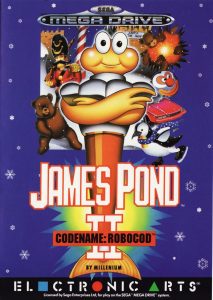
James Pond II is the sequel to the critically acclaimed James Pond: Underwater Agent released just the year before. Taking obvious cues from James Bond, and in this instance, Robocop, as well, James Pond II is an absolute joy to play. Such was the popularity of this title, it was released across over 15 different systems. It was also notable for its product placement of the Penguin Chocolate biscuit bar in the UK. Soon after the release of the game, it has been reported that Penguin outsold its rival Kit-Kat soon after the game released. Also, check out the theme tune, it’s the cutest version of Robocop!
Pond, now armed with his Robosuit supplied by F.I.S.H. (Finned Investigators of Shady Humans) has to once again face off with his arch-enemy, Dr. Maybe (a play on Dr. No). This time he has retreated to Santa’s Grotton in the North Pole and enslaved his helpers, which are usually penguins. Your mission, should you choose to accept it is to free the penguins, retrieve all the stolen toys, and defeat Dr. Maybe. for good!
The game takes place across various themed stages of toys. There are no weapons to defeat your enemies, but you do have a generous jump ability. Your Robosuit allows for vertical movement by allowing you to extend your body to the platform above to move past or drop on your enemies. Once you have collected two penguins in a level, you do it again, and then it’s time for a boss. Occasionally you have access to a vehicle which can make things go a lot quicker.
Just writing about it now, it is making me want to fire up my Mega Drive for a quick blast. I even remember the cheat code for invincibility. At the start of the hub level, if you collect the cake, hammer, earth, apple, and tap in that order, you will be granted invincibility. Those eagle-eyed of you will notice the first letters of each word, when put together spells CHEAT.
PGA Tour Golf (1991)

PGA Tour Golf is the first game in the PGA series. Developed by Sterling Silver Software and released on PC in 1990, with Electronic Arts publishing, of course, it was going to end up on consoles and even the Sega Game Gear. Once again Rob Hubbard was brought it for the music. The game was praised for the realism in its graphics and balance of simplicity with the gameplay. PGA Tour Golf raised the bar to set the standard for gold games to come, introducing new conventions such as the three-button swing. This allowed for accuracy, power, and direction of the swing.
Other than your standard tournament, there is Driving and Putting practice. The game takes place across four courses, three real ones, and a fictional one called Sterling Shores. Your opponents in the tournaments are all top US golfers, some of which will offer you advice before you start a hole. Another standard that PGA Tour Golf used was the grid when putting. This allowed the player to see the contours of the green to prepare their putt accordingly. The game isn’t much to look at now, but it is still great fun to play and is solely responsible for my enjoyment of golf games, despite not actually liking the sport.
Road Rash (1991)
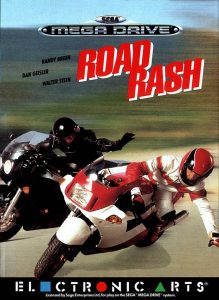
As I write this, I am listening to the soundtrack from the game. This is the most kickin’ soundtrack of any Mega Drive game. So much so I am actually going to learn it on guitar. There is nothing better than cruising through the Sierra Nevada and clubbing punks of their bikes to these tunes. They are timeless, even after all these years I am able to hum along with them. Again, thank you Rob Hubbard for creating the best gaming tunes ever!
Anyway, now I got that out of my system, Road Rash motorbike racing game where you are taking part in illegal races set across five stages based in the USA. The game was both developed and published by Electronic Arts and took about 21 months. The name came about from one of the designers riding down a road in Southern California and thinking “Man if you wiped out here, you’d get some serious road rash”
In these races, you start off at the back and have to race, kick, punch, and club your way to the front. By default, you don’t have a club you can use, but you can steal them off other bikers to wipe them out. All this while avoiding traffic, oil slicks and random cows just lying in the road. Although these cows act as a ramp, it isn’t always best to try and run into them. Your bike does have a damage meter and you can fall or be knocked off. This will result in you having to run back to your bike losing valuable seconds. Watch out for the cops too, because if they catch you after you fall, you are busted and the race is over.
The idea is to win the race for a cash prize. This can be used to buy better bikes each with its own speed or weight advantages. Once you win all five races in your division, you then progress on to the next. These are essentially the same tracks but longer and the AI difficulty ramps up. Road Rash II is often quoted as the best in the series, but the original Road Rash is where my heart is. It is also worth checking out the Master System port, it looks every bit as good as its 16-bit brother.
Desert Strike: Return To The Gulf (1992)
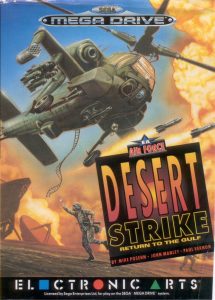
In a recent poll on Twitter, I asked what people thought the best ‘Strike’ game is on the Mega Drive. It confirmed my personal opinion that it is Desert Strike with a whopping 65% of 238 votes. This, I wholly believe to be true. At one point the game was removed from shelves in the UK because of the references to the Gulf War, though development began before the Gulf War had even started. The game’s original titles were Apache AHX: Desert Madman and Beirut Breakout as it was originally based on the Lebanese War. The name and game change was inspired by Operation: Desert Storm, a real-life operation from the Gulf War. Despite the controversy surrounding the timing of its release so soon after the Gulf War and featuring the likeness of Saddam Hussein, Desert Strike became its highest selling game at the time.
Self-appointed General Kilbaba and dictator is looking to wage World War III on the US. The President has personally chosen you to stop this terrorist attack before nuclear war breaks out. You pilot an Apache helicopter which bears some resemblance to an actual Apache, but not all. There are four missions in total, which doesn’t sound a lot but they will require planning and tactful thinking to complete effectively.
As mentioned before, you fly an Apache chopper on an isometric playing field. Each of your missions will have several objectives for you to complete, all the while picking up and M.I.A.’s on the way. These can vary from escorting a bus to safety to blowing up a SCUD missile depot. All this using your guns and Hellfire missiles while outmanoeuvring enemy gunfire and picking up fuel to keep yourself going. IF you make it to the end, you even get a sequence involving then-President George Bush with his wife Barbara. A magnificent game that places strategic planning over an all-out attack!
Lotus II R.E.C.S. (1993)
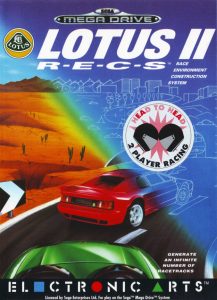
Otherwise known as LOTUS III: The Ultimate Challenge on home computers, this was one of three games that carried the Lotus license. Lotus II was developed by Magnetic Fields, so publishing was handed over the Electronic Arts while Gremlin Interactive handled the home computers. What this game does is take the best parts of the first two games, and puts them in one game with an additional car and its crowning glory – the Race Environment Construction System (R.E.C.S.). This is basically a course creator with endless possibilities.
At its core, Lotus II is an arcade-style racing game where you can either take part in time trials or race against AI opponents. The options to what you can drive are sadly limited to the Lotus Elan SE, Lotus Esprit SE, and the concept Lotus M200. But the stages vary enough to make up for the lack of driving options. Also one of the few games where the sprite scaling worked really well in two-player split-screen mode.
So There We Have It…
This was the first half of my Top 20 EA Games Of The 20th Century chosen between 1986 and 1993. Obviously, this is purely my opinion and I actively encourage debate. Did I miss anything out in this time period? Was there something there you didn’t expect to see? What would you like to have seen in this list? What do you want or expect to see in part 2? Let us know in the comments below, we would love to hear about your favourite EA games from back in the day.

YouTube | FaceBook | Twitter | Instagram| Twitch | Discord | Podcast
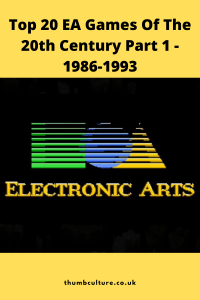
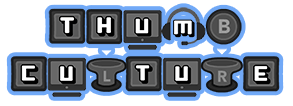
Superb read mate about one of my favourite game houses of this era. You forget just how many classics they fired out never mind all the sports as well. Enjoyed that a lot with ma wee coffee and biccie, thanks 🏴😎☕
Thanks for your comments Stewart! Glad you enjoyed the post 🙂
Fantastic article and a great read. I had most of these ( still have some ) and it brought back amazing memories. Gaming has come a long way and not always for the better.
Thank you Pete, glad you enjoyed the article. Keep your eyes peeled for part two!